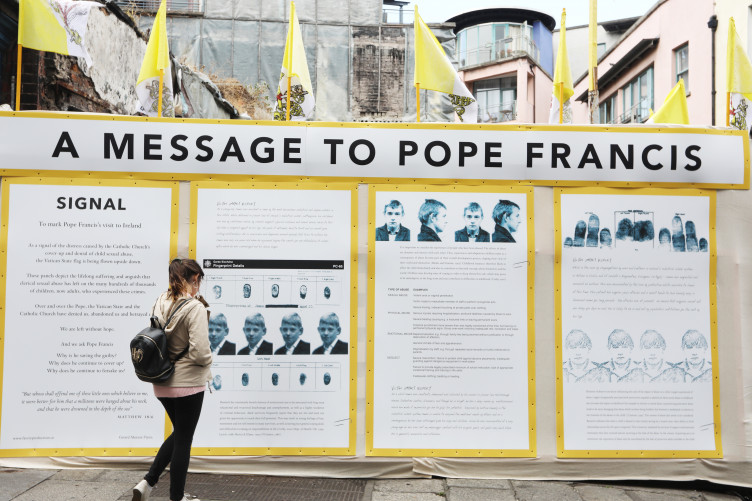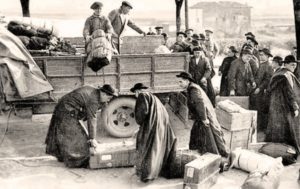Not Easy Being Pope
So much breaking news! Last week I filed this blog before the Pope’s statement, summarized well in LaCroix. A nice statement, but, as Paul Moses notes in Commonweal, similar to what he said in 2015 when he met survivors – and Attorney General Shapiro? – in Philadelphia. This is an excellent analysis of what the Pope said, strengths and weaknesses. It’s not easy being Pope.
And what the Pope says now is not enough. He presents no plan on how to move from the current clericalism to a lay-led church. No blueprint, though there are many structures that could easily be adopted in the American church – those many committees that meet, but are always subject to the pastor’s authority. Or the Bishop’s. And where is the National Lay Board of Overseers to evaluate the United States Conference of Catholic Bishops (USCCB)? I can imagine that. Elected by us all. Of course, we may not do so well if we are subjected to political campaigns as we are in our secular life. But isn’t it intriguing to think about?
There is so much being published that I will only draw your attention to four articles that relate women’s issues and lay control in this crisis moment. If you want more information, NCR has a section on its website that lists all it is publishing just about every few minutes, it seems. It’s called Accountability, a headline that emphasizes the role of the Catholic press in the discussion about change in the church. America and Commonweal have had a similar flood of articles. And the secular press has, too, just not as much, though James Carroll goes on about the Pope and Ireland and the need to include women in the New Yorker.
In my first article, Phyllis Zagano asks “Will we ever know the truth?” She expresses some sympathy for a beleaguered Pope, the focus of my post. She notes the reforms Francis has implemented and his recognition that “the church is not only its clergy.” And she probes more deeply: “Maybe we should have paid more attention to last century’s priestly exodus. Many priests left to marry. Many others simply left. Why? Not all who remained are dishonest, but what honest man could maintain sanity and remain silent if he knew bishops and others hid more than simple shenanigans? For years.”

A NEW ART installation which will give the public an opportunity to see “exactly how the issue of child sexual abuse impacts on individuals” has been finished in Temple Bar, Dublin.
Yes, and almost all priests who stayed in failed to suggest that the clerical culture could have been improved by including women as equals, not as partners of married men to be ordained deacons, but as priests and deacons themselves. Zagano recalls Frank Keating’s comment, “To resist grand jury subpoenas, to suppress the names of offending clerics, to deny, to obfuscate, to explain away; that is the model of a criminal organization, not my church.” This allusion to the Mafia accompanied his resignation as the first chair of the USCCB sex abuse commission. Zagano calls Cardinals DiNardo and Wuerl “tone deaf” when they suggest that “a panel of bishops” conduct an investigation now. Pope Francis, would you support lay control, not mere involvement?
Second, Kathleen Sprows Cummings writes in the New York Times that “Gradual Reform Is No Longer an Option.” I am so delighted to discover such an articulate voice, new to me. She uses her teaching, now at Notre Dame in South Bend, Indiana, so effectively, to write:
I often use a handy metaphor to explain to my students how feminists have historically differed among themselves in their approaches to bringing about change in patriarchal institutions. Some feminists seek a place at the table; others want to reset the table. The former hope to promote gradual progress from within an existing framework of norms and organizational structures; the latter demand nothing less than radical, wholesale reform.
When it comes to the Roman Catholic Church, I have always been a “place at the table” kind of feminist. When asked how to integrate women more fully into the life of the church, I offer reasonable strategies. Bishops could, for example, recognize that the call for leadership might flow as much from the sacrament of baptism as from that of ordination, and appoint more women to leadership positions at all levels of church governance.
Tuesday’s grand jury report about clerical sexual abuse in Pennsylvania has changed my mind. The sickening revelations — over 1,000 victims, more than 300 priests, 70 years of cover-ups — have propelled me directly to the center of the “reset the table” camp. We need to rip off the tablecloth, hurl the china against a wall and replace the crystal with something less ostentatious, more resilient and, for the love of God, safer for children.
Sprows Cummings “demands that church leadership voluntarily relinquish their place at the head table,” and she provides a script for homilies, news conferences, and USCCB statements:
“We were granted privileges because we were meant to represent Jesus Christ on earth. But Jesus said that we should humble ourselves like little children if we want to enter the Kingdom of Heaven, and also that anyone who harms a little one ‘would be better drowned in the depths of the sea with a great millstone around his neck.’ We are no longer worthy of your sacred trust.
“We are ready to listen humbly, first of all to victims and their advocates, who might tell us how to begin to ease suffering and to make recompense. We welcome prosecutors and lawyers and historians into our archives, so that the full truth, however damning, might be known. We acknowledge that our system of seminary education is deeply flawed, and ask how it might be reformed so as to produce leaders who thrive as human beings. We submit to new layers of oversight, because the ones we ourselves imposed failed so miserably. We are listening. We are learning. We ask for God’s mercy, and yours.”
I can’t do better than that in any summary; I just wish she had these clerics recognize the way sexism and patriarchy created the environment in which these sins are possible, and extend an invitation to women to set the table, to join the priesthood, to create a new priestly ministry, as WOC’s early slogan proclaimed.
But leave that up to those quoted in the third article, an AP release by David Crary, specifically our own Kate:
The current scandals suggest that church leaders, over the years, have placed a priority on “protecting abusers and silencing survivors,” said Kate McElwee, executive director of the Women’s Ordination Conference.
Pope Francis, she noted, has called on lay Catholics to help create a new culture in the church that would curtail sex abuse and “clericalism” — the policy that places priests on a pedestal.
“It seems obvious to me you need to abandon the old boys’ club and have everyone at the table,” McElwee said.
I love that Kate continues the table analogy, and goes on to see ordaining women deacons as a step towards the priesthood, though an “incomplete” step.

“Worker Priests,” 1941
Another suggestion in that article I see nowhere else is from Michael Higgins, a professor of Catholic Thought at Sacred Heart University in Fairfield, Connecticut. He recalls the “worker priest” movement during and after World War II, which had priests in factories but was a little too radical to be continued in the 1950s. That tradition continues to influence those who want a “community-oriented church,” which Higgins suggests would be a great model for women’s priesthood. Natalia Imperatori-Lee, a professor of religious studies at Manhattan College in Riverdale, New York, also supports this model but does not see it happening soon because history shows that “voluntary relinquishing of power,” in this case by an exclusively male clergy, is rare. Margaret McGuinness, a religion professor at La Salle University in Philadelphia, is similarly doubtful about the prospects for women priests. In contrast, I think women are already breaking down the barriers between clergy and laity. How often do people prefer sisters to priests when they serve in parishes? How many more women, from after college to old age, are in the trenches as volunteers in social justice ministries here and abroad? A crisis makes necessary a reconsideration of what ordination actually should mean.
Fourth, again a question, this one from Johanna Moorhead in The Guardian, “How dare the pope ask ordinary Catholics to atone for child abuse?” This columnist is another new voice to me. She suggests that the church should “include the very people who could have helped it be a better organization: its ‘faithful.’ Democracy is dismissed, frowned on, ignored.” She campaigned for women’s ordination 30 years ago and reports that once John Paul II shut down debate on the subject, she tried to engage with priests who brought conversations to “an abrupt end.” She concludes, “The proper response … is to reduce the power of the clergy – and to call in those who just might be able to give it some help to get back on the rails. In other words: the people of God. Try it, Francis.”
It’s not easy being Pope.

2 Responses
Hierarchy is not the problem. Homosexuality is not the problem. Celibacy is not the problem. Clericalism is just one symptom of the problem. Ecclesiastical PATRIARCHY is the problem!
The road to hell is paved with good intentions, and we keep traveling on that road as long as the church hierarchy is an ecclesiastical patriarchy.
The sexual abuse crisis is a symptom of gender imbalance and the consequent abuse of power rooted in original sin (Genesis 3:16). Evidence is mounting that gender imbalance in the church hierarchy exacerbates the abuse of power, including sexual abuse of minors and women.
The only way to mitigate this tragedy is to discard the patriarchal “binary” as enshrined in the code of canon law (#1024) and ordain women to the priesthood and the episcopate. Contrary to what the Vatican has been saying for decades, there is no dogmatic impediment.
For the redemption, and the sacramental economy, the masculinity of Jesus is as incidental as the color of his eyes. Jesus is the bread of life, not the male of life. What matters is that God became flesh, not male. The substance of the Eucharist is flesh, not accidentals such as XX or XY chromosomes.
Before the redemption, under the Old Law, it made sense for Jesus to call 12 males to represent the patriarchs of the 12 tribes of Israel. After the redemption, under the New Law, it no longer makes sense because male sacrifice is no better than female sacrifice. Would Jesus today call 12 males to represent the patriarchs of the 12 tribes of Israel?
The Catechism of the Catholic Church, section 1577, is a doctrinal fabrication to rationalize the patriarchal priesthood and defend what is no longer defensible. Section 1598 declares that the exclusively male priesthood is a choice (first sentence, note the word “only”) and who can make the choice (second sentence, note the word “alone”).
Patriarchy is a disordered attachment to the supremacy of masculinity. If the entire ecclesiastical patriarchy re signs, and is replaced by another ecclesiastical patriarchy, in a few years we are going to be back to the same mess.
As long as this systemic issue is not resolved, any institutional pretension of reform is an exercise in futility. It is time for the Vatican to stop messing around and allow Christ to call women to the priesthood and the episcopate.
Excellent article, Regina, bringing in many different voices with many good suggestions for real action for change, to end the system that perpetuated a culture in which rampant child sexual abuse could be tolerated and covered up for so long. I hope the Pope gets a copy, and the bishops too!